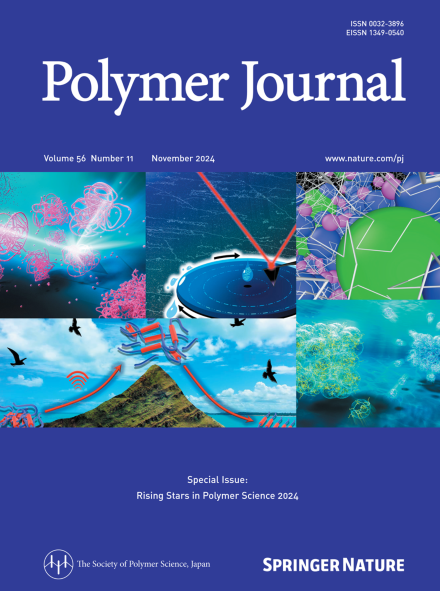利用生物基聚合物的精确交联设计开发功能可降解材料
IF 2.7
4区 化学
Q3 POLYMER SCIENCE
引用次数: 0
摘要
石油基塑料重量轻,耐用,具有优异的成型性。然而,全球塑料产量的增加,加上新兴国家的经济发展,以及由此造成的塑料垃圾对海洋的污染,近年来已经成为严重的问题。多糖,如淀粉和纤维素,是自然界中最丰富的生物聚合物,由于其可再生、可持续性和生物降解性,是特别有前途的塑料替代品。然而,由于多糖膜缺乏耐水性和足够的力学性能,在一次性塑料中的大规模应用受到限制,因为在许多日常场景中首选耐水性。需要进一步的研究来优化生物塑料,使其在经济上和实践上可行。在本报告中,我们将重点关注刺激反应材料,这些材料可以形成或分离交联结构,以响应外部刺激或环境的微小变化。我们开发了在淡水和海水中具有不同崩解/溶解速率的淀粉基薄膜作为环保材料。将变性淀粉与氧化纤维素或水溶性聚合物混合,制备透明、均匀的薄膜。引入氢键后,淀粉络合膜在淡水中稳定;然而,在海水中,氢键交联解离,导致薄膜迅速溶解。这项技术平衡了海洋环境中的可降解性和日常环境中的耐水性,提供了减少海洋塑料污染的另一种方法,预计将应用于各种工业部门。在这项研究中,我们开发了淀粉基薄膜,其在淡水和海水中的分解和溶解速度可调。将改性淀粉与氧化纤维素或水溶性聚合物混合,制成透明、均匀的薄膜。在淡水中,氢键使膜稳定,而在海水中,氢键交联解离,使膜迅速溶解。该技术在日常环境中的耐水性和海洋条件下的受控分解之间取得了战略平衡,为石化塑料提供了一种可持续的替代品,在各个工业领域都有潜在的应用前景。本文章由计算机程序翻译,如有差异,请以英文原文为准。

Development of functional degradable materials by precise crosslinking design of biobased polymers
Petroleum-based plastics are lightweight and durable and exhibit excellent formability. However, the increase in global plastics production, coupled with the economic development of emerging countries, and the resulting marine pollution caused by plastic waste have become serious problems in recent years. Polysaccharides, such as starch and cellulose, are the most abundant biopolymers in nature and are particularly promising plastic alternatives owing to their renewability, sustainability, and biodegradability. However, owing to their lack of water resistance and adequate mechanical properties, large-scale application of polysaccharide films in single-use plastics is limited because water resistance is preferred in many daily scenarios. Further research is required to optimize bioplastics to make them economically and practically feasible. In this report, we focus on stimuli-responsive materials that form or dissociate cross-linked structures in response to slight changes in external stimuli or the environment. We developed starch-based films with different disintegration/dissolution rates in freshwater and seawater as environmentally friendly materials. Modified starch was mixed with oxidized cellulose or a water-soluble polymer to prepare a transparent, homogeneous film. After the introduction of hydrogen bonds, the starch complex film was stable in freshwater; however, in seawater, the hydrogen bond crosslinks dissociated, causing the film to dissolve rapidly. This technology balances degradability in marine environments with water resistance in everyday environments, providing an alternative means of reducing marine plastic pollution, and it is expected to be applied in a variety of industrial sectors. In this study, we developed starch-based films with tunable disintegration and dissolution rates in freshwater and seawater. The modified starch was mixed with oxidized cellulose or a water-soluble polymer to produce transparent, homogeneous films. Hydrogen bonding stabilized the films in freshwater, while in seawater, the hydrogen bond crosslinks dissociated, causing the film to dissolve rapidly. This technology offers a strategic balance between water resistance in everyday environments and controlled disintegration in marine conditions, presenting a sustainable alternative to petrochemical plastics with potential applications across various industrial sectors.
求助全文
通过发布文献求助,成功后即可免费获取论文全文。
去求助
来源期刊

Polymer Journal
化学-高分子科学
CiteScore
5.60
自引率
7.10%
发文量
131
审稿时长
2.5 months
期刊介绍:
Polymer Journal promotes research from all aspects of polymer science from anywhere in the world and aims to provide an integrated platform for scientific communication that assists the advancement of polymer science and related fields. The journal publishes Original Articles, Notes, Short Communications and Reviews.
Subject areas and topics of particular interest within the journal''s scope include, but are not limited to, those listed below:
Polymer synthesis and reactions
Polymer structures
Physical properties of polymers
Polymer surface and interfaces
Functional polymers
Supramolecular polymers
Self-assembled materials
Biopolymers and bio-related polymer materials
Polymer engineering.
 求助内容:
求助内容: 应助结果提醒方式:
应助结果提醒方式:


